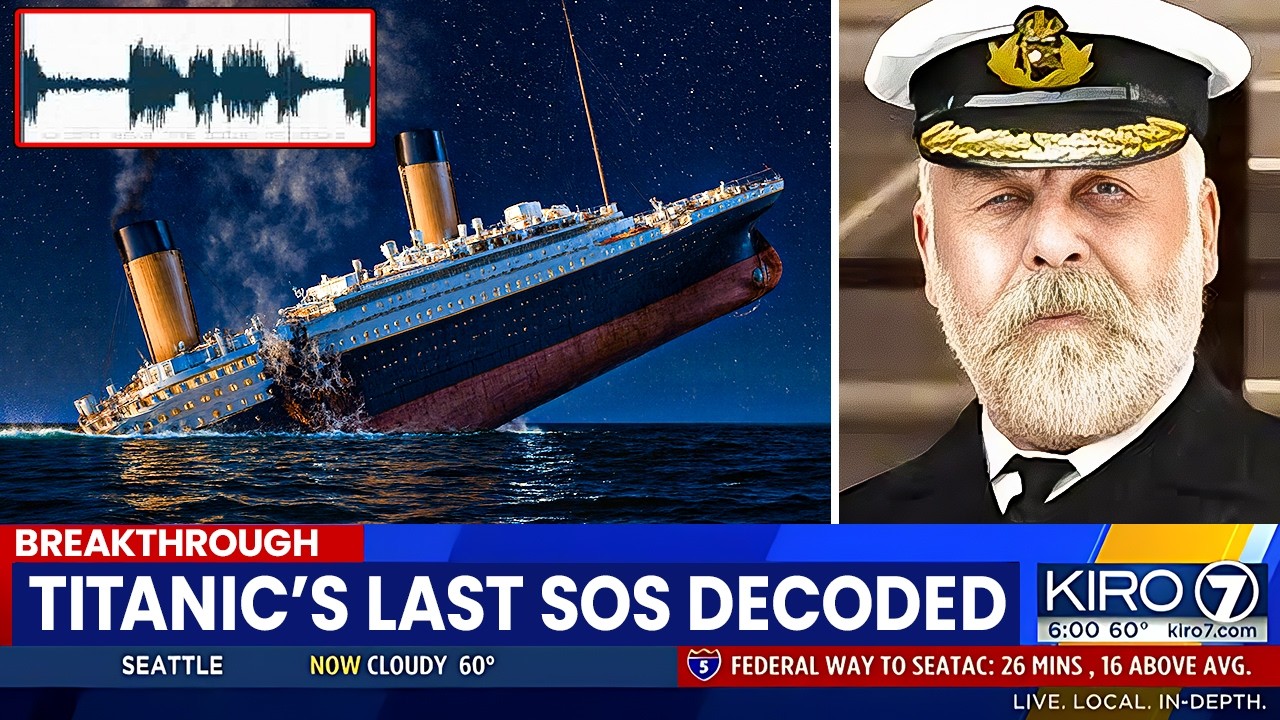🚨 BREAKING: Experts just decoded the Titanic’s FINAL SOS message, and what they found is beyond shocking! 😱 The chilling truth hidden in those last desperate signals has left the world stunned. Could this rewrite history?
Click to uncover the jaw-dropping details:

On April 15, 1912, the RMS Titanic, deemed “unsinkable,” struck an iceberg and sank in the North Atlantic, claiming over 1,500 lives. The ship’s wireless operators, Jack Phillips and Harold Bride, sent desperate distress signals—using both the Marconi CQD code and the newer SOS—forming a haunting telegraphic record of its final hours. In 2025, viral claims assert that experts have “just decoded” the Titanic’s final SOS, revealing shocking secrets that left them speechless. Yet, no credible evidence supports a newly decoded message. Instead, recent advancements, like a detailed 3D scan of the wreck, have shed light on the physical events of that fateful night. This article explores the Titanic’s distress signals, the latest scientific findings, the myth of a new decoding, and why this century-old tragedy continues to captivate us.
The Titanic’s Distress Signals
When the Titanic struck an iceberg at 11:40 PM on April 14, 1912, its wireless operators sprang into action. The ship was equipped with a state-of-the-art Marconi wireless system, a novelty at the time, used mostly for passenger messages. After the collision, Captain Edward Smith ordered Phillips and Bride to send distress calls. They began with CQD, the Marconi distress signal (“CQ” for general call, “D” for distress), broadcasting, “CQD DE MGY [Titanic’s call sign], Come at once. We have struck a berg.” As the situation worsened, Bride suggested using SOS, adopted in 1908 but rarely used by British operators. Phillips interspersed SOS with CQD, sending messages like “SOS CQD MGY, We are sinking fast, passengers being put into boats.” These signals reached ships like the Carpathia (58 miles away), which arrived at 4:00 AM to rescue 705 survivors, and the Frankfurt, which caused confusion with delayed responses. The final transmission, at 2:17 AM, was “CQD DE MGY,” cut off as the ship sank three minutes later. These messages, decoded in real-time, have been preserved in archives, notably by historian John Booth, and are not newly deciphered.
Recent Discoveries: The Digital Scan
In 2025, a groundbreaking 3D scan of the Titanic wreck, conducted by Magellan and Atlantic Productions, produced a “digital twin” using 715,000 images. Featured in the National Geographic documentary Titanic: The Digital Resurrection (April 2025), this scan revealed new details about the ship’s final moments. The bow lies upright on the seafloor, while the stern, 600 meters away, is a mangled heap, confirming the violent breakup as it sank. The scan corroborates eyewitness accounts, such as engineers working in Boiler Room 2 to keep lights and the wireless operational until the end, and refutes myths, like First Officer William Murdoch’s alleged suicide, showing he was swept away while launching a lifeboat. A simulation by University College London’s Prof. Jeom-Kee Paik used the scan and blueprints to model the sinking, estimating a 6.3-second collision with the iceberg, causing A4-sized hull punctures. These findings, while stunning, focus on physical evidence, not new SOS decodings.
The Myth of a Newly Decoded SOS
The claim of a “just decoded” SOS appears to be a misrepresentation. The Titanic’s distress signals were decoded in 1912 by receiving ships and have been studied extensively since, with transcripts published in inquiries like the 1912 U.S. Senate and British Wreck Commissioner’s reports. No 2025 reports, including those from NASA, the International Astronomical Union, or maritime historians, mention a new decoding. On X, posts amplify the claim, often linking to clickbait articles like “Titanic’s Final SOS Decoded!” but provide no verifiable sources. The confusion may stem from misinterpretations of Morse code analyses, such as a 2020 blog by Carl Kruse recreating the Titanic’s signals, or conflation with the 2025 wreck scan’s revelations. In 1936, a ham radio operator claimed to receive delayed Titanic SOS echoes, but this was debunked as impossible due to radio wave propagation. The “speechless” reaction likely reflects media hype around the digital scan’s vivid imagery, not a new signal breakthrough.
Why the Confusion?
The Titanic’s story is ripe for sensationalism. Its distress calls, described as the ship’s “own words,” carry emotional weight, with phrases like “Sinking by the head” evoking the crew’s desperation. The 2025 scan’s detailed visuals, showing scattered passenger artifacts like purses and pocket watches, amplify this, stirring public imagination. Viral media exploits this, blending historical signals with modern discoveries to create clickbait. The SOS, a universal symbol of distress, adds drama, but its 1912 adoption was not novel for the Titanic—contrary to myths, it wasn’t the first ship to use it. Misinformation thrives on platforms like YouTube, where videos exaggerate findings to draw views, a pattern seen in other mysteries like MH370.
Scientific and Historical Context
The Titanic’s wireless was a technological marvel, but its limitations contributed to the tragedy. Operating on a single frequency, operators couldn’t send and receive simultaneously, causing delays. The nearby SS Californian, stopped in ice, missed the signals because its operator, Cyril Evans, had gone to bed after Phillips told him to “shut up.” This led to inquiries blaming Captain Stanley Lord, though later reviews suggested limited impact due to timing. The 1912 Radio Act and International Convention for the Safety of Life at Sea, prompted by the disaster, mandated 24-hour radio watches and standardized SOS, improvements still in use today. The 2025 scan, while not decoding new signals, reinforces these lessons by showing the physical toll of the sinking, validating survivor accounts and correcting myths.
Cultural Fascination
The Titanic endures as a symbol of human hubris and heroism, with its distress signals immortalized in films like A Night to Remember (1958) and Titanic (1997). Newald’s claim of alien abduction or MH370’s fisherman tales show how mysteries invite speculation, and the Titanic is no exception. The 2025 documentary’s visuals, described as letting researchers “walk through the ship,” intensify this fascination, but the “decoded SOS” narrative is a modern myth, not a scientific breakthrough. The emotional pull of 1,500 lost lives drives interest, as does the hope of new revelations, even if unfounded.
Challenges and Future Prospects
Verifying a new SOS decoding is impossible without evidence, and none exists in 2025 records. The Titanic’s signals are fully documented, and further wreck exploration, like RMS Titanic Inc.’s planned telegraph recovery, faces legal hurdles but could yield artifacts, not new messages. AI and digital modeling may refine sinking simulations, but radio signal analysis is unlikely to uncover new data after 113 years. The focus remains on preserving the wreck, a UNESCO cultural heritage site since 2012, as it deteriorates.
Conclusion
The claim that Titanic’s final SOS was “just decoded” is a compelling but baseless narrative, likely conflating the 2025 digital scan’s revelations with historical signals. The real breakthroughs—detailed wreck imagery and simulations—offer tangible insights, confirming heroic efforts and tragic failures without needing new decodings. The Titanic’s story, with its poignant distress calls, continues to resonate, but we must separate fact from fiction. As we explore its legacy, the ship remains its own witness, telling its tale through evidence, not sensationalism.





